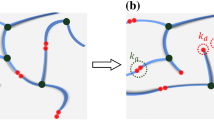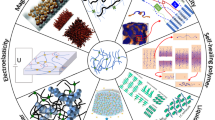Abstract
Polymers that mechanically respond to the presence of a diffusing fluid/solvent have found various applications in drug delivery, tissue scaffolding, sensors and actuators. These applications involve understanding of both the diffusion process and the evolution of the deformation of the polymers during the diffusion process. For example, in a polymeric actuator one might be interested in the extent of deformation one can achieve given a solvent environment and the time in which it can be achieved. There are two key aspects in modeling such behavior. First, the displacement gradients involved are usually large, especially in problems such as “self-assembly.” Second, since the diffusion occurs in a deforming polymeric medium, an appropriate diffusion model that includes the effect of the deformed state of the body as well as the interaction between the polymeric medium and the diffusing fluid has to be considered. In effect, this results in the diffusion and equilibrium equation being fully coupled and nonlinear. In this work, we model diffusion-induced deformation in an elastic material including large deformations based on thermodynamics framework. For the chemical potential, we use the Flory–Huggins potential adapted to include the effect of stress in the polymers. Using the model, we simulate folding and bending of a rectangular polymeric strip by simultaneous solution of the diffusion equation as well as the equilibrium equation using the finite element method. Parametric studies are also conducted in order to examine the effect of material parameters on the diffusion and deformation behaviors. Finally, using the coupled diffusion–deformation model we simulate deformations of composite domains comprising of polymeric constituents with different diffusion–deformation behaviors in order to achieve various interesting “self-assembly” shapes.
Similar content being viewed by others
References
Bawa P., Pillay V., Choonara Y.E., du Toit L.C.: Stimuli-responsive polymers and their applications in drug delivery. Biomed. Mater. (Bristol, England). 4, 022,001 (2009)
Chester, S.A., Di Leo, C.V., Anand, L.: A finite element implementation of a coupled diffusion-deformation theory for elastomeric gels. Int. J. Solids Struct. 52, 1–18 (2014)
Flory P.J.: Thermodynamics of high polymer solutions. J. Chem. Phys. 10, 51–61 (1942)
Flynn C.P.: Point Defects and Diffusion. Clarendon Press, Oxford (1972)
Guan J., He H., Hansford D.J., Lee L.J.: Self-folding of three-dimensional hydrogel microstructures. J. Phys. Chem. B 109, 23,134–23,137 (2005)
Gueribiz D., Jacquemin F., Fréour S.: A moisture diffusion coupled model for composite materials. Eur. J. Mech. A Solids 42, 81–89 (2013)
Guo W., Li M., Zhou J.: Modeling programmable deformation of self-folding all-polymer structures with temperature-sensitive hydrogels. Smart Mater. Struct. 22, 115,028 (2013)
Hirai T.: Electrically active non-ionic artificial muscle. J. Intell. Mater. Syst. Struct. 18, 117–122 (2006)
Hoffman A.S.: Stimuli-responsive polymers: biomedical applications and challenges for clinical translation. Adv. Drug Deliv. Rev. 65, 10–16 (2013)
Hong W., Liu Z., Suo Z.: Inhomogeneous swelling of a gel in equilibrium with a solvent and mechanical load. Int. J. Solids Struct. 46, 3282–3289 (2009)
Hong W., Zhao X., Zhou J., Suo Z.: A theory of coupled diffusion and large deformation in polymeric gels. J. Mech. Phys. Solids 56, 1779–1793 (2008)
Hu Z., Zhang X., Li Y.: Synthesis and application of modulated polymer gels. Science 269, 525–527 (1995)
Huggins M.L.: Some properties of solutions of long-chain compounds. J. Phys. Chem. 46, 151–158 (1942)
Kalaitzidou K., Crosby A.J.: Adaptive polymer particles. Appl. Phys. Lett. 93, 041,910 (2008)
Kee D.D., Liu Q., Hinestroza J.: Viscoelastic (non-Fickian) diffusion. Can. J. Chem. Eng. 83, 913–929 (2005)
Larche F., Cahn J.: The effect of self-stress on diffusion in solids. Acta Metall. 30, 1835–1845 (1982)
Liu, Y., Oh, L., Fanning, S., Shapiro, B., Smela, E.: Fabrication of folding microstructures actuated by polypyrrole/gold bilayer. 12th International Conference Transducers, Solid-State Sensors, Actuators and Microsystems. 1, 786–789 (2003)
Luo R., Li H., Lam K.Y.: Modeling and analysis of pH-electric-stimuli-responsive hydrogels. J. Biomater. Sci. Polym. Ed. 19, 1597–1610 (2008)
Mano J.: Stimuli-responsive polymeric systems for biomedical applications. Adv. Eng. Mater. 10, 515–527 (2008)
Mudunuru M., Nakshatrala K.: A framework for coupled deformation–diffusion analysis with application to degradation/healing. Int. J. Numer. Methods Eng. 89, 1144–1170 (2012)
Randall C.L., Gultepe E., Gracias D.H.: Self-folding devices and materials for biomedical applications. Trends Biotechnol. 30, 138–146 (2012)
Ren L., Qiu J., Wang S.: Thermo-adaptive functionality of graphene/polydimethylsiloxane nanocomposites. Smart Mater. Struct. 21, 105,032 (2012)
Toh W., Liu Z., Ng T.Y., Hong W.: Inhomogeneous large deformation kinetics of polymeric gels. Int. J. Appl. Mech. 05, 1350,001 (2013)
Wallmersperger, T., Kroeplin, B., Holdenried, J., Guelch, R.W.: Coupled multifield formulation for ionic polymer gels in electric fields. In: Y. Bar-Cohen (ed.) SPIE’s 8th Annual International Symposium on Smart Structures and Materials, pp. 264–275. Int. Soc. Optics Photon. (2001)
Weitsman Y.: Stress assisted diffusion in elastic and viscoelastic materials. J. Mech. Phys. Solids 35, 73–93 (1987)
Zakharchenko S., Sperling E., Ionov L.: Fully biodegradable self-rolled polymer tubes: a candidate for tissue engineering scaffolds. Biomacromolecules 12, 2211–2215 (2011)
Zhang J., Zhao X., Suo Z., Jiang H.: A finite element method for transient analysis of concurrent large deformation and mass transport in gels. J. Appl. Phys. 105, 093,522 (2009)
Author information
Authors and Affiliations
Corresponding author
Rights and permissions
About this article
Cite this article
Parthasarathy, S.S., Muliana, A. & Rajagopal, K. A fully coupled model for diffusion-induced deformation in polymers. Acta Mech 227, 837–856 (2016). https://doi.org/10.1007/s00707-015-1483-3
Received:
Published:
Issue Date:
DOI: https://doi.org/10.1007/s00707-015-1483-3




